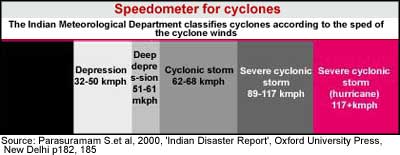Cyclones in India
 The term cyclone includes all tropical storms. They start as swirls of cloud and rain that eventually intensify into storms.The Indian sub-continent is the worst affected part in the world. Although India accounts for only six per cent of the cyclones worldwide, it records the maximum damage. Past 122 years' data shows November and May have the maximum cyclone frequency over the North Indian Ocean. Cyclones devastate life and property in the affected areas. The 1999 Orissa super cyclone rendered a third of the population homeless. The 1998 Gujrat cyclone caused export losses worth about Rs 8,400 million at the Kandla port
The term cyclone includes all tropical storms. They start as swirls of cloud and rain that eventually intensify into storms.The Indian sub-continent is the worst affected part in the world. Although India accounts for only six per cent of the cyclones worldwide, it records the maximum damage. Past 122 years' data shows November and May have the maximum cyclone frequency over the North Indian Ocean. Cyclones devastate life and property in the affected areas. The 1999 Orissa super cyclone rendered a third of the population homeless. The 1998 Gujrat cyclone caused export losses worth about Rs 8,400 million at the Kandla port
Natural guardians |
Mangrove forests protect against cyclones. Their disappearance spells doom for the coastal communities |
| • Mangrove minimise devastation to human settlements, flora and fauna from cyclones. • Clearing forests and mangrove has intensified the cyclonic destruction as winds that were counteracted by vegetation now sweep over the land. • Mangrove forests are under threat from human encroachments, land reclamation, illegal clearing and agricultural practices. |
Related Content
- Affidavit on behalf of Union Territory of Puducherry on forest cover, 25/04/2025
- Affidavit by the state of Goa on forest cover in the state, 25/04/2025
- The impact of climate change on education and what to do about it
- Annual climate summary 2023
- State of the global climate 2023
- No change to warming as fossil fuel endgame brings focus onto false solutions
